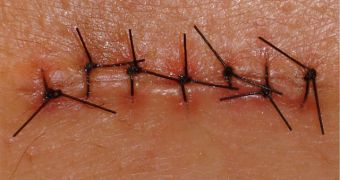Imagine you pass through a surgery and never "see" the surgeon again. That's because he/she does not need to remove the threads.
A biopolymer suture approved by the FDA (Food and Drug Administration) is made of compounds that our organism naturally produces and are safely absorbed when the wound is healed. These threads are also more effective, 30 % stronger than current ones and very flexible, so the surgeons can work easier with them.
The sutures were developed a Cambridge company, Tepha, Inc., and could be employed to create an array of absorbable medical devices, like stents, surgical meshes and possibly a heart valve scaffold. The new sutures will be important for abdominal closures, vulnerable to re-opening, tendons and ligaments.
These are the first absorbable sutures based on compounds synthesized by genetically modified bacteria.
20 years ago, a team at Massachusetts Institute of Technology led by biology professor Anthony Sinskey started genetic engineering on different bacteria, focusing on a group of genes that encode enzymes that synthesize polyesters. These polyesters disintegrate after a while into metabolites naturally occurring in the human body, so they can be absorbed with no harm.
The genes were transferred into a strain of E. coli that can synthesize huge amounts of the strong, flexible polymer. "Tepha plans to start marketing them soon, in partnership with another company", said Simon Williams, Chief Executive of Tepha. "Not only is it technically and in an engineering sense a tremendous victory, but it's also a victory for society because this leads to new medical devices that can help people in new and novel ways," said Sinskey, co-founder and co-director of Tepha. "What we've found is that this one material seems to be finding a lot of use in different applications, because of its wide range of desirable properties," said Williams.
Tepha is going to develop more medical devices, like surgical meshes, multifilament fibers and stents. An artificial scaffold employed for growing heart valves after being implanted in a patient would spare children with heart valve defects from passing through repeated surgeries. "We've been able to show we can produce a valve scaffold that functions better and can grow with the animal. If the valve can grow with the patient, you don't need the repeated surgeries," said Williams.

 14 DAY TRIAL //
14 DAY TRIAL //